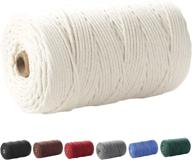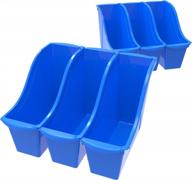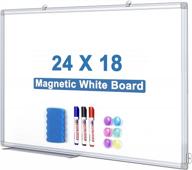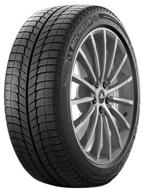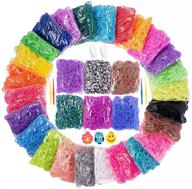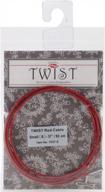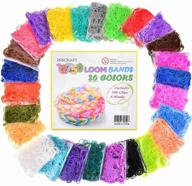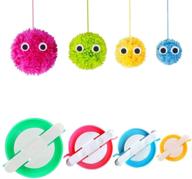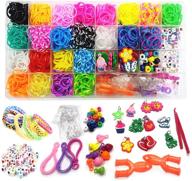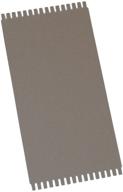Another interesting products
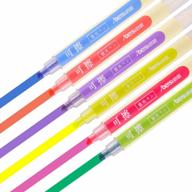

29 Review

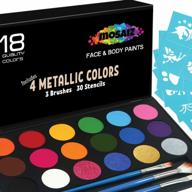

36 Review

Discover the Joy of Weaving and Spinning
Introduction
Weaving and spinning are timeless fiber arts that allow you to create beautiful fabrics and yarns from scratch. Learning these traditional crafts connects you to cultures across history while providing a meditative, hands-on experience. Whether you're an absolute beginner or looking to expand your skills, exploring the world of weaving and spinning can bring tremendous satisfaction and joy.
Essential Supplies for Beginners
Starting out with weaving and spinning requires some basic equipment and materials:
- Loom - The three main types are rigid heddle, table, and floor looms.
- Spinning wheel - Choose between modern or traditional styles.
- Fiber - Wool, cotton, silk, and blends for spinning; yarn for weaving.
- Shuttles, bobbins, spindles - For holding fiber and weaving yarn.
- Scissors, tape measure, warping pegs - Helpful tools.
- Drop spindles - Inexpensive way to learn spinning.
Look for beginner kits that package everything you need to start out.
Choosing a Loom
| Loom Type | Description |
|---|---|
| Rigid Heddle | Affordable, portable option good for beginners. |
| Table Loom | Versatile for weaving wider fabrics. |
| Floor Loom | Larger looms capable of complex projects. |
Consider your space, budget and project goals when selecting a loom.
Learning Basic Weaving Techniques
Mastering a few fundamental techniques will get you started weaving on any loom:
- Warping - Measuring and threading lengthwise warp threads.
- Dressing - Attaching warp threads to the loom.
- Wefting - Weaving horizontal weft threads over and under warps.
- Beating - Pushing weft into place with the beater bar.
- Finishing - Removing project from loom and securing ends.
Have patience, take notes, and don't be afraid to start over as you learn!
Picking Your First Spinning Wheel
Choose an entry-level spinning wheel with these features:
- Single treadle
- Lower orifice - Easier for beginners to draft fiber.
- Higher whorl - Spins yarn more slowly.
- Smooth operation
Later you can explore more advanced wheels with double treadles and ratios.
Mastering Spinning Fibers into Yarn
Follow these steps to spin fibers into yarn:
- Load bobbin onto wheel and tension drive band.
- Draft fibers by pulling them from the roving.
- Allow twist into drafted fibers by turning wheel.
- Pinch drafted fibers to form yarn.
- Wind freshly spun yarn onto bobbin.
Take time to coordinate your hands, feet and wheel speed as you build this skill!
Tips for Avoiding Common Beginner Mistakes
- Don't rush the warp - Precise measuring prevents mistakes.
- Check tension frequently - Adjust as needed.
- Control draw-in when weaving - Prevent sides from curving inward.
- Draft evenly when spinning - Create consistent yarn.
- Practice treadling and wheel speed - Develop coordination.
Be patient with yourself as you learn - you'll get better with time and practice!
Essential Supplies for Beginner Weavers and Spinners
When embarking on fiber arts like weaving and spinning for the first time, having the right tools and materials on hand will set you up for success. Building a beginner's toolkit allows you to safely practice techniques without frustration. Consider gathering the following essential supplies as you start your journey into traditional weaving and spinning crafts.
Looms
A loom holds the warp threads taut while you weave the weft through them to create fabric. Common beginner looms include:
- Rigid Heddle - Portable and affordable at $100-$300. Limited to plain weave.
- Table Loom - Versatile for wider fabrics at $300-$1200. More capabilities than rigid heddle.
- Tapestry Loom - Simple frame style for smaller woven wall-hangings under $200.
Consider getting a used loom to save money as you start out. Check for damage and test the moving parts before purchasing.
Spinning Wheels
Spinning wheels twist and wind fibers into yarn. Good starter wheels include:
- Ashford Joy - Single treadle at $400-$600. Popular choice for beginners.
- Louet S10 - Compact and portable for $400-$500.
- Schacht Matchless - Versatile high-quality wheel for $700-$900.
Try out different spinning wheels to find one with a smooth treadling action that suits you.
Fibers
You'll need fibers for spinning and yarn for weaving. Recommended materials for beginners:
- Wool - Soft and easy to spin. Good for weaving.
- Cotton - Plant-based fiber that's stronger when woven.
- Acrylic - Inexpensive yarn great for learning to weave.
- Roving - Wool prepared for handspinning.
- Ribbon/novelty - Adds interest when learning to spin.
Purchase fiber samples or kits to get experience with different materials.
Weaving Tools
Handy tools for weaving include:
- Shuttles - Hold weft yarn and pass through warps. $5-$20.
- Tape measure - Essential for precise warp length. $5-$10.
- Warping peg set - For measuring out warp threads. $20-$50.
- Scissors - Snip yarn ends. Embroidery style works well. $5-$10.
You may also want picking sticks, a warping board, and raddle as you advance.
Spinning Tools
Must-have spinning accessories include:
- Bobbins - Hold spun yarn on wheel. $5-$20 each.
- Niddy noddy - For skeining spun yarn. $20-$30.
- Drop spindles - Portable spinning tool for beginners. $10-$30.
- Lazy kate - Holds bobbins for plying yarn. $20-$50.
Fiber supplies like carders, hackles, and dye materials can wait until you progress.
Equipping your studio thoughtfully with quality beginner tools will give you an enjoyable foundation in weaving and spinning crafts.
Similar products
Choosing a Loom as a Beginner Weaver
One of the most exciting purchases when starting out in weaving is your very first loom. With so many options available, choosing a beginner-friendly loom that suits your space and budget takes some consideration. Focus on loom types, size, cost, and capabilities as you make this important decision.
Rigid Heddle Loom
This portable loom has a tight heddle frame that lifts threads using built-in shafts. Benefits include:
- Compact size - Good for tight spaces or portability.
- Affordable price - Often under $300.
- Easy set-up - Attach warp threads and weave.
- Versatile - Weave scarves to towels with creative warping.
Ideal if you need a simple, inexpensive introduction to weaving.
Table Loom
Table looms allow more versatility than rigid heddle looms. Key features:
- Multiple harnesses - Allow advanced weave structures.
- Wider weaving width - From 15" up to 60".
- Folds up when not in use.
- Higher cost - $500 to $1,500+.
A great choice if you want to progress past plain weave techniques.
Floor Loom
Sturdy floor looms excel at wider projects. Considerations include:
- Heavy and large - Permanent space required.
- Very wide weaving width - From 24" up to 60".
- Multiple harnesses - Easily create advanced weaves.
- Significant investment - $1,000 to $5,000+.
Ideal for serious weavers ready to commit space and budget.
Used Looms
Buying used can save money as a beginner if you inspect carefully:
- Test all moving parts - Ensure proper function.
- Inspect for damage - Cracks, warped wood, etc.
- Evaluate included accessories - Some have bonus tools.
- Consider needed repairs - Factor cost into price.
Joining weaving groups can connect you to available looms in your area.
Kits for Beginners
Beginner loom kits bundle useful supplies:
- Prepared warp - Allows you to weave immediately.
- Weaving tools - Shuttles, needles, etc.
- Accessory items - Niddy noddy, warping pegs.
- Fiber and yarn - Enough to complete first projects.
Convenient option to get everything at once.
Final Loom Selection Tips
- Factor in size - Choose a loom that fits your space.
- Consider portability - If needed for classes or travel.
- Get quality tools - Avoid flimsy or defective looms.
- Think long term - Get capabilities you'll grow into.
- Ask fellow weavers - For recommendations based on experience.
With research and planning, you'll find the ideal beginner loom to start your weaving journey!
Top products in 🧶 Weaving & Spinning
Learning Basic Weaving Techniques as a Beginner
Weaving may seem complicated at first, but mastering a few fundamental techniques will give you the skills to create beautiful handwoven fabrics. Take things step-by-step as you learn these essential weaving methods.
Warping the Loom
Warping attaches the lengthwise warp threads to the loom in an orderly pattern. Follow these steps:
- Measure out the desired number and length of warp threads using a warping peg or board.
- Thread warp threads through the heddles in order, using a cross or threading hook.
- Secure warp threads to the back beam, threading through the raddle to maintain even tension.
- Wind warp threads onto the front beam by turning the beam or winding on a crank.
Warping with precision is key to avoiding mistakes! Using a warping helper can be extremely useful.
Dressing the Loom
Dressing attaches warp threads to the loom so you can begin weaving:
- Separate warp threads into upper and lower layers using lease sticks.
- Insert a shed rod through the opening to maintain the shed.
- Attach each warp thread to the cloth beam using tacks or knots.
- Remove lease sticks and check for crossed threads to correct.
Take care when dressing the loom to prevent tangled warps.
Weaving Plain Weave
Plain weave, or tabby weave, is the most common over-under structure:
- Pass shuttle left to right over top threads.
- Beat the weft into place with the beater.
- Pass shuttle back right to left underneath threads.
- Beat after each pass to keep edges straight.
This simple technique will become second nature with practice.
Advancing the Cloth
Advancing the woven fabric regularly is important:
- When within about 8” of finished fabric, stop weaving.
- Cut or unclamp cloth from the front beam.
- Rewind fabric onto the beam, removing finished sections.
- Re-clamp fabric to the beam.
Advancing the warp allows you to continue weaving longer pieces.
Finishing Woven Fabric
Finish the woven cloth using these steps:
- Trim any loose threads at the edges.
- Untie or cut woven fabric from the loom.
- Secure any loose warp and weft threads.
- Wash, press, or block the fabric as desired.
Now you have a completed handwoven project ready for your own use or to give as a gift!
Learning just these few techniques will equip you to weave a wide variety of fabrics. Be patient with yourself and you’ll be creating beautiful cloth before you know it.
How Amazon Prime Benefits Weaving and Spinning Enthusiasts
As an avid weaver or spinner, having an Amazon Prime membership can be extremely useful for conveniently and affordably stocking all of your fiber art supplies.
Free Two-Day Shipping
With Prime's free two-day shipping on eligible items, you can quickly receive yarn, tools, equipment, and other weaving and spinning must-haves. This allows you to quickly replenish materials you use in your projects without needing to take an extra trip to the craft store.
Prime Wardrobe
The Prime Wardrobe feature lets you try on eligible clothing items like handwoven garments for up to 7 days before deciding what to keep. This makes it easy to order handmade items online and only pay for what you love.
Prime Video
Brush up on your skills or learn new weaving and spinning techniques by streaming instructional videos included with Prime. You can master everything from warping a loom to ply-split braiding using the Prime Video library.
Prime Reading
Expand your knowledge in the fiber arts with unlimited access to a rotating selection of eBooks on weaving, spinning, knitting, dyeing, and more through Prime Reading. You can learn on the go by downloading books right to your tablet or e-reader.
Digital Photos
Store an unlimited number of photos of your handiwork through Prime Photos so you can easily share your intricate weaving and spinning projects with fellow fiber enthusiasts or use them for inspiration.
With these value-added Prime benefits tailored for crafters, an Amazon Prime subscription can be a smart investment for anyone passionate about weaving, spinning, and fiber arts.
How To Choose The Right Weaving And Spinning Equipment For Your Project?
Choosing the right weaving and spinning equipment for your project can be a daunting task, but it is essential to ensure that you have the right tools for the job. Here are some tips to help you choose the right equipment for your project:
- Consider the type of loom you need: There are different types of looms available, such as inkle looms, rigid-heddle looms, table looms, and floor looms. Each type of loom has its advantages and disadvantages, so it is essential to choose the one that best suits your needs.
- Determine your skill level: If you are a beginner, it is best to start with a small loom, such as a rigid-heddle, inkle, or table loom. If you are an experienced weaver, you may want to invest in a large floor loom or a more complex table loom.
- Consider the size of the loom: The size of the loom you choose will depend on the size of the project you want to undertake. If you plan to weave large pieces, you will need a larger loom.
- Look for portability: If you plan to take your loom with you to workshops or events, you will need a portable loom.
- Check the quality of the equipment: The quality of the equipment you choose will affect the quality of your finished product. Look for equipment made from high-quality materials that will last for years.
- Consider your budget: Weaving and spinning equipment can be expensive, so it is essential to consider your budget when choosing equipment. You may want to start with a basic loom and upgrade as your skills and budget allow.
- Seek advice from experts: If you are unsure which equipment to choose, seek advice from experts. Many weaving and spinning supply stores offer guidance and advice to help you choose the right equipment for your project.
- Discover the Joy of Weaving and Spinning
- Introduction
- Essential Supplies for Beginners
- Choosing a Loom
- Learning Basic Weaving Techniques
- Picking Your First Spinning Wheel
- Mastering Spinning Fibers into Yarn
- Tips for Avoiding Common Beginner Mistakes
- Essential Supplies for Beginner Weavers and Spinners
- Looms
- Spinning Wheels
- Fibers
- Weaving Tools
- Spinning Tools
- Choosing a Loom as a Beginner Weaver
- Rigid Heddle Loom
- Table Loom
- Floor Loom
- Used Looms
- Kits for Beginners
- Final Loom Selection Tips
- Learning Basic Weaving Techniques as a Beginner
- Warping the Loom
- Dressing the Loom
- Weaving Plain Weave
- Advancing the Cloth
- Finishing Woven Fabric
- How Amazon Prime Benefits Weaving and Spinning Enthusiasts
- Free Two-Day Shipping
- Prime Wardrobe
- Prime Video
- Prime Reading
- Digital Photos
- How To Choose The Right Weaving And Spinning Equipment For Your Project?






